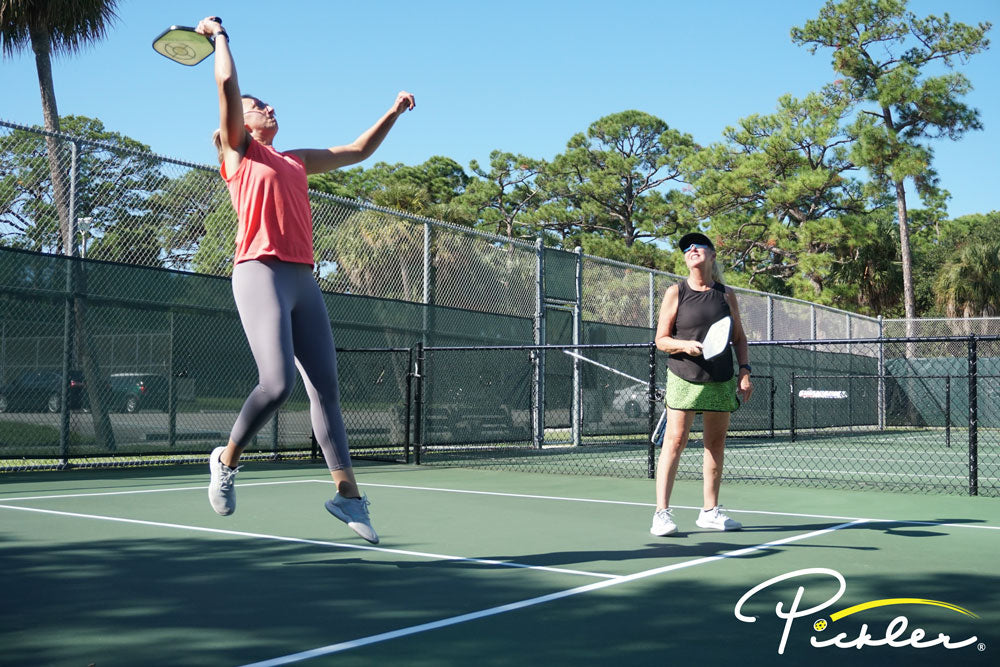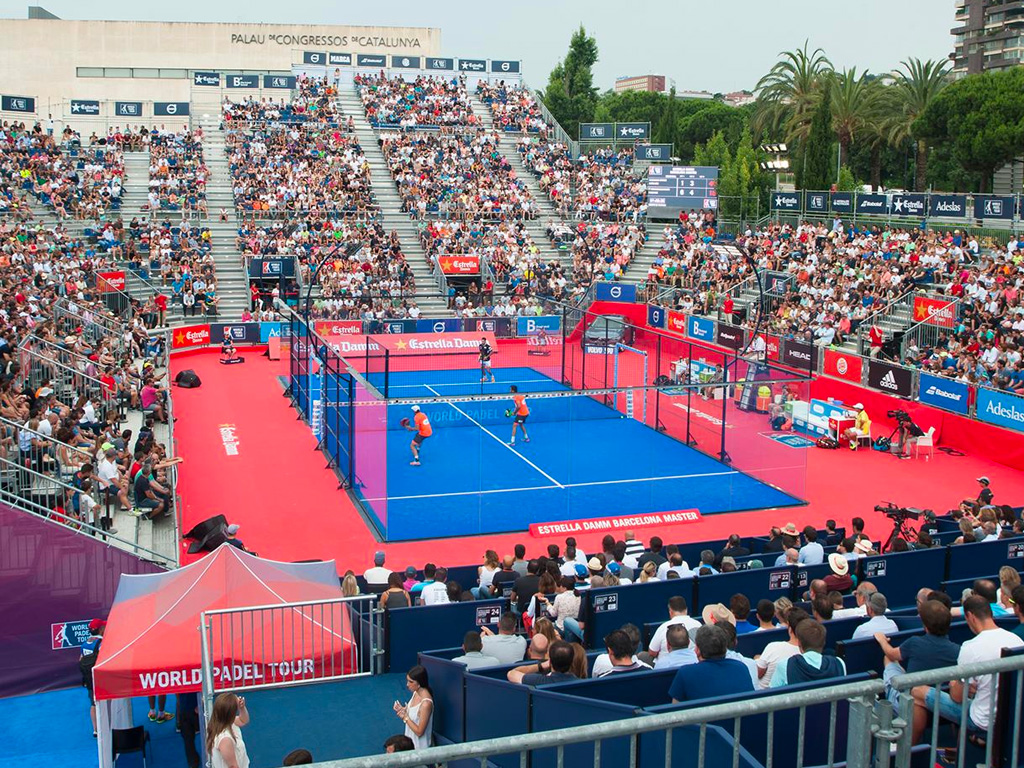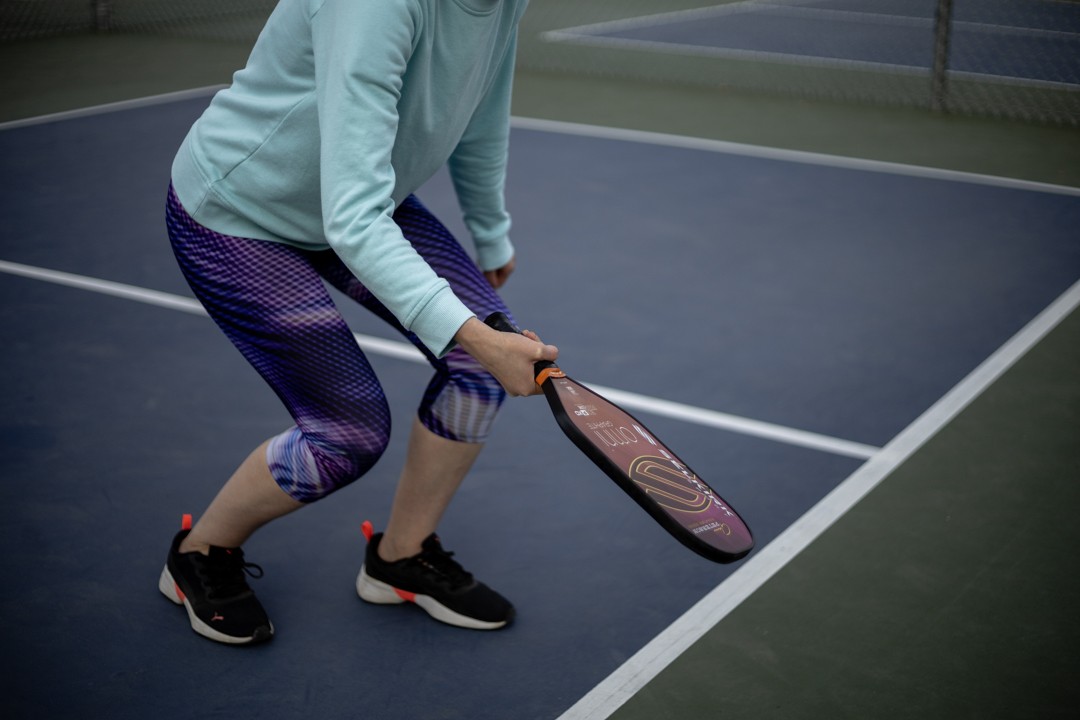
Paddle ball (or "Padel") is a game between two teams that takes place on a court that is both a Ping-Pong and tennis court. It can be played outdoors or indoors. The USA Pickleball Association regulates and the game is quickly becoming popular in Europe & Asia. There are more than 3,000 courts worldwide with players from all over the world.
Light colored clothing is required for the game. The safety thong must be tied around the wrist of players. This must be attached securely to the handle of your paddle. The paddle must not be moved between the player's hands. Both hands must be used when striking the ball.
The game is played to 11 or 15 points. The serving side scores a point when it serves an "ace" or wins the rally. Points can be lost if a teammate hits the ball and doesn't return it. The play will be re-recorded if the ball is hit with a foreign object. Sometimes, the referee may stop play.

Play begins with the tossing of a coin. The coin will be used to determine which team serves first. The coin toss winner may accept or decline the offer. The coin toss winner must accept or decline the offer. After that, the server must stay in a zone of service for at least one hour. The second server is awarded the serve if the first team drops a point.
After the server has served the ball, the player should call a safe or block. These calls may be used to signal injury fear or indicate that an opponent is in the way of the ball. If an opponent blocks the ball's path, they must be moved. But the opponent cannot prevent the striker from moving. The striker can, however, move if an opposing player moves in the striker’s direction to prevent them from blocking the shot.
Players should strike the ball using a solid paddle or textured paddle. The ball bounce can be affected by the size of the paddle. Some players prefer a stiff paddle, while others prefer a strung tennis racquet. A player should allow the ball's bounce to occur before volleying.
A player should not allow the ball to touch their body during a rally. A player who strikes the ball using a textured paddle cannot use their hand or push against the opponent's shot. You can also use your arm to push your opponent, but that must be a legal hit.

A referee is necessary for any tournament. The referee must always be located above the back wall unless the opponent has been injured. The referee should be able see all sides of the court from his position.
If a player is unable continue play, it will be immediately suspended for fifteen minutes. If the server is incapacitated, a second player may be summoned to take over.
FAQ
What does nutrition do to your body?
Your body functions properly when you have the right nutrition. It is important to eat a balanced diet, rich in fruits and veggies, lean proteins, whole grain, and healthy fats.
Which Is Most Important: Diet, Exercise, or Sleep?
The answer depends on what you want to achieve. Diet is key to losing weight. For building muscle mass, exercise is key. Finally, sleep is the least important factor since it only affects how well you perform during the day.
Do I need heat before exercising?
Warming up before a sport can help reduce muscle soreness and increase performance. You can use several methods to warm up: walking, running, jumping rope, stretching, and cycling are just a few examples. You should start slow and gradually increase your speed and intensity.
What is the value of good nutrition?
Our health and well-being depends on our nutrition. A healthy diet includes fruits, vegetables, whole grains, lean protein, and dairy. Eating nutritious foods helps us stay fit and active, which leads to better overall health.
Statistics
- In 2018, the World Health Assembly agreed on a global target to reduce physical inactivity by 15% by 2030 and align with the Sustainable Development Goals. (who.int)
- One study showed that adults who watch more than 4 hours of television daily had an 80% higher risk of death from cardiovascular disease. (heart.org)
- Physical activity confers the following maternal and fetal health benefits: a decreased risk of pre-eclampsia, gestational hypertension, gestational diabetes (for example, 30% reduction in risk) (who.int)
- In high-income countries, 26% of men and 35% of women were insufficiently physically active, as compared to 12% of men and 24% of women in low-income countries. (who.int)
External Links
How To
How to Burn Belly Fats Faster
When we are trying to lose weight, belly fat is often seen as a problem. When you stop and think about it, Belly Fat can actually be a blessing. Your organs are protected from being damaged by excess belly fat. Let's now see how to quickly lose belly fat.
Stress and inactivity are two of the major factors that cause us to store body fat. Because stress stimulates the release of cortisol hormone, it makes us hungry all the time. Cortisol is responsible for an increase in insulin levels. The insulin then stores extra calories as fat. Insufficient sleep can lead to an increase in appetite and adrenaline release. These extra calories can also be reduced by exercise
There are many ways you can reduce belly fat. All of these methods can be used, depending on your budget. These are some great tips to help you lose belly fat fast.
-
Eat less food. Don't eat three large meals at once. This way, you'll consume fewer calories overall.
-
Make sure you drink plenty of water. Water flushes out toxins and keeps you hydrated. You won't overeat if you drink water before you eat.
-
Avoid eating unhealthy snacks. If you're looking for quick fixes, snack foods like chips, cookies, candies, etc. Although tempting, they can be very unhealthy. But avoid these fattening treats as they contain lots of empty calories and too much sugar. Choose healthy options like whole grains, fruits, vegetables, nuts, seeds and nuts.
-
Three times per week, strength training is recommended. Strength training increases muscle mass, which can help you burn more calories while still resting. It strengthens bones muscles ligaments, tendons and the heart.
-
Move regularly and stretch. Stretching can improve flexibility, mobility, and reduce back pain. Walking is great for burning calories.
-
Reduce alcohol intake. Your diet is empty of calories, and alcohol has no nutritional content.
-
You can lose weight slowly. Your current weight is the first step to losing weight. Next, calculate your ideal weight by adding between 5% and 10% to your total body weight. Once you have calculated your target body weight, you can begin to cut calories by 500-1000 calories every day until your goal is reached.
-
Avoid processed food. These foods are high-in salt, sugar, as well as preservatives. Processed foods are often very convenient but don't provide enough nutrients to keep you healthy.
-
Don't skip breakfast! Breakfast is good for your concentration, memory, and energy. Breakfast should include protein (like eggs), fiber (like oats), and complex carbohydrates (like oatmeal).
-
Have regular bowel movements. Bloating and gas can be caused by irregular bowel movements and constipation. To prevent this, drink plenty of water and increase fiber intake.